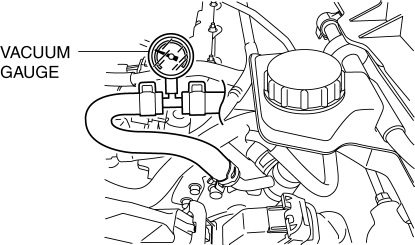
Erratic or low-vacuum gauge readings indicate theres a real problem with the engine or the. When installing the gauge open the compensation valve to allow this pressure to vent.

Unplug the vacuum hose from the intake manifold and connect it to the tee fitting that comes with your vacuum gauge if your engine uses a carburetor dont connect the gauge to it.
How to install vacuum gauge. If you are installing a vacuum gauge inside of the vehicle mount the gauge according to the manufacturers instructions. If the gauge needs vacuum run a vacuum hose from the T-fitting into the vehicle. Locate where the wiring harness enters the firewall slowly push the vacuum line in through the rubber grommet and route it to the gauge.
In this update i show you guys how to install a vacuum gauge and where you can tap into the vacuum lines. I give you tips on where gauges can go and demonstrate how the gauge will help you save money. Cut the Vacuum Line that is coming from the Intake Manifold that you are going to use and install the T-Fitting.
Make sure that the barb with the brass fitting is used for the gauge connection. If the BoostVacuum Line is not in line with the brass fitting the gauge could flutter or make noise. Slide the BoostVacuum Line onto the T-Fitting and secure.
DO NOT OVER TIGHTEN ADAPTER FITTING OR GAUGE MAY BE DAMAGED. Gauges may be mounted in In-dash holes or in Auto Meter custom mounting Solutions. Secure gauge with mounting clamps.
Holes and install rubber grommet where pressure or vacuum line passes through sheet metal. Im thinking about installing a vacuum gauge onto a 2008 Toyota Vios Yaris sedan in the US as a sort of fuel economy meter. Im just undecided as to where to tee into intake manifold vacuum.
I initially thought of either the brake booster hose or the PCV hose but on the 1NZ-FE in this car both these hoses are really thick and have double. Please like a subscribe. If you need anymore help comment and Ill try my best to answer.
When installing the gauge open the compensation valve to allow this pressure to vent. It should then be closed again to prevent any external ingress. After you mount the gauge set the compensating valve from CLOSE to OPEN.
INSTALLING GAUGE INTO GAUGE PANEL OR IN-DASH 1. Insert gauge through front of panel or hole in dashboard. Hold gauge case and rotate gauge as needed until gauge dial face is prop- erly positioned in front of dashboard panel.
Jump to Latest Follow 1 - 15 of 15 Posts. Joined Sep 19 2008 49 Posts. Discussion Starter 1 Feb 2 2009.
I need some help installing my vacuum gauge on my 2005 RS. Ive read the other post but the setup is different from the EJ253. If someone can help that would be wounder full lol.
Remove the top screw cap that will be the front molding when the boost gauge is installed into the mounting panel. The top of the gauge screws off and then the gauge is placed behind the mounting panel and inserted into the panel so the front screw cap can be secured onto the gauge. Need vacuum to operate and that vacuum comes from the engine.
If an engine is down on vacuum these devices may not function properly. Conversely if the vacuum consumers have a problem it creates a vacuum leak degrading proper engine operation. Erratic or low-vacuum gauge readings indicate theres a real problem with the engine or the.
To begin start the engine and let it run until it has reached normal operating temperature. Find a vacuum port to connect the gauge to. Ideally it should be on the manifold or below the base of the carburetor.
Where it shouldnt be is high atop the carburetor on the air cleaner or any of the emissions control paraphernalia. Unplug the vacuum hose from the intake manifold and connect it to the tee fitting that comes with your vacuum gauge if your engine uses a carburetor dont connect the gauge to it. You need direct vacuum from the intake manifold.
Then connect the other end of the tee fitting to the intake manifold. Now connect the gauge to the tee fitting. After all there is no other convenient place to install the vacuum gauge on a typical system there are only two ports on the entire residential system.
The answer is vacuum rated core tools. Using core tools allows two important things to happen. First removal of the core which is a significant restriction and second it provides a place.